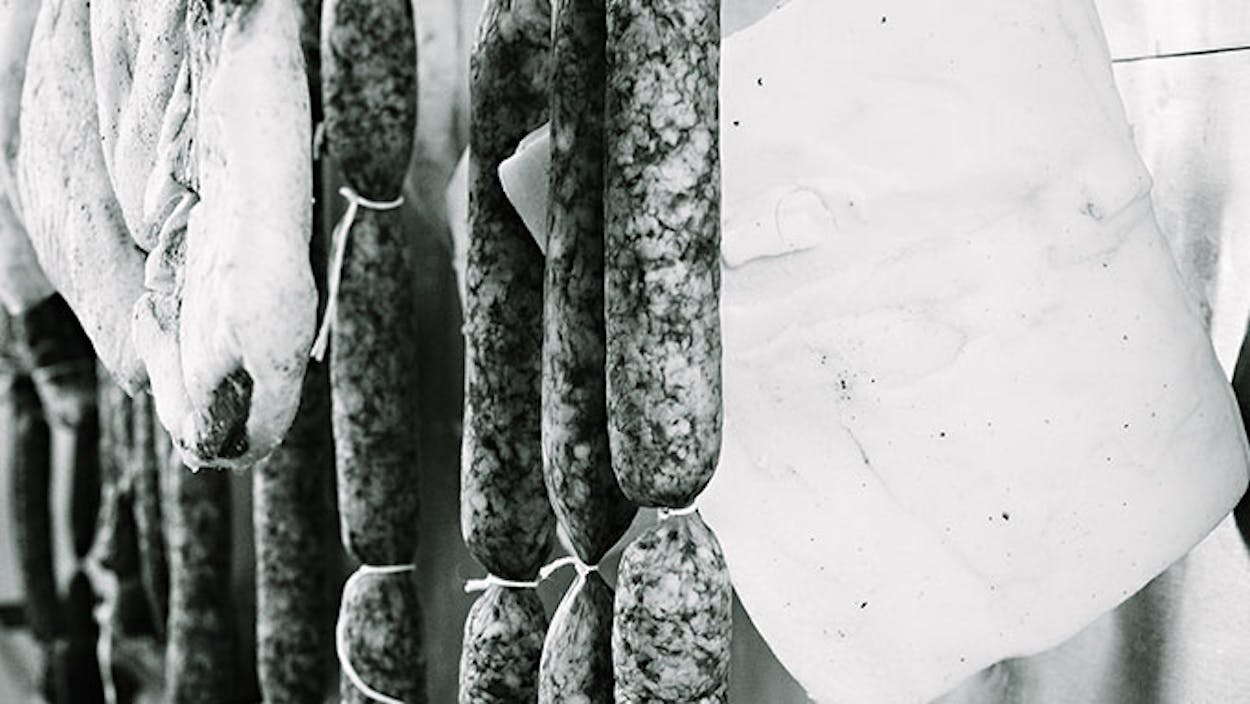A feast fortwo had just been laid in front of Morgan Weber and me: a link of boudin, smoked brisket from an Augustus Ranch steer, a lamb-pastrami sandwich on a pretzel bun, and, the star of any show at Revival Market, a gorgeous charcuterie platter full of house-cured prosciutto, coppa, lardo, and salami. Weber, who opened this cozy grocery store and meat market on Houston’s Heights Boulevard back in 2011 with chef Ryan Pera, had already had lunch. So had I. But not to worry—we finished the entire spread.
Charcuterie, the ancient craft of preserving meat, has taken off in Texas over the past few years, but don’t mistake it for some newfangled trend. The smoked sausage you get at any Texas barbecue joint is a close cousin of these meats. The recent spike in popularity comes partly from the growing number of chefs who are looking for ways to make use of whole animals and offcuts in their restaurants. There’s plenty left over after the loins and chops are sliced away, and as Weber says, “There’s only so much rendered lard you can sell.” Today, you can find top-quality house-made ’nduja, mortadella, lonzino, and more in every big Texas city. In San Antonio, there’s the recently opened Cured, from chef Steve McHugh, and in Dallas, chef David Uygur does his best to honor the Italian craft of salumi at his restaurant, Lucia. (Salumi refers to all salt-cured meats; salami is the plural of salame.)
Austin has a particularly strong charcuterie scene. Dai Due, Jesse Griffiths’ supper club, cooking school, and butcher shop, will be launching a brick-and-mortar restaurant this year. Kocurek Family Charcuterie had a good run at the farmers’ markets for a couple of years. Now Lawrence Kocurek is chef de cuisine at Trace, in the W Hotel, where his charcuterie plate is a big draw. And there’s Salt & Time, a full-service butcher shop and restaurant in East Austin opened last year by Ben Runkle and Bryan Butler, who started by selling salumi in local farmers’ markets in 2010. Much like Revival Market, Salt & Time specializes in whole-animal butchery. What doesn’t go straight into the meat case is made into all forms of inventive salumi—the lardo is coated with Szechuan peppercorns and the lomo is rubbed with ground coffee.
Among this crowd, Revival Market is the old man. Weber and Pera’s original vision for the place came from Weber’s fond memories of the long-closed City Meat Market in Yoakum, which he visited regularly as a child. It is also in Yoakum that the heart of Revival Market resides: a seventy-head herd of Berkshire and Mangalitsa hogs foraging on nearly a thousand acres at Revival Ranch. The number of hogs is so few that Weber would be considered a hobbyist if not for the market component of his business. But being his own best customer is what makes the small-scale operation viable. Depending on the time of year, Revival Market will go through one or two whole hogs per week. They’ll get broken down into case-ready cuts like chops and collar steaks, and the trim and fat will become the raw material for Pera’s charcuterie. It’s an efficient closed system with nothing wasted. And it produces some of the tastiest meat in Texas.
- More About:
- Daniel Vaughn









